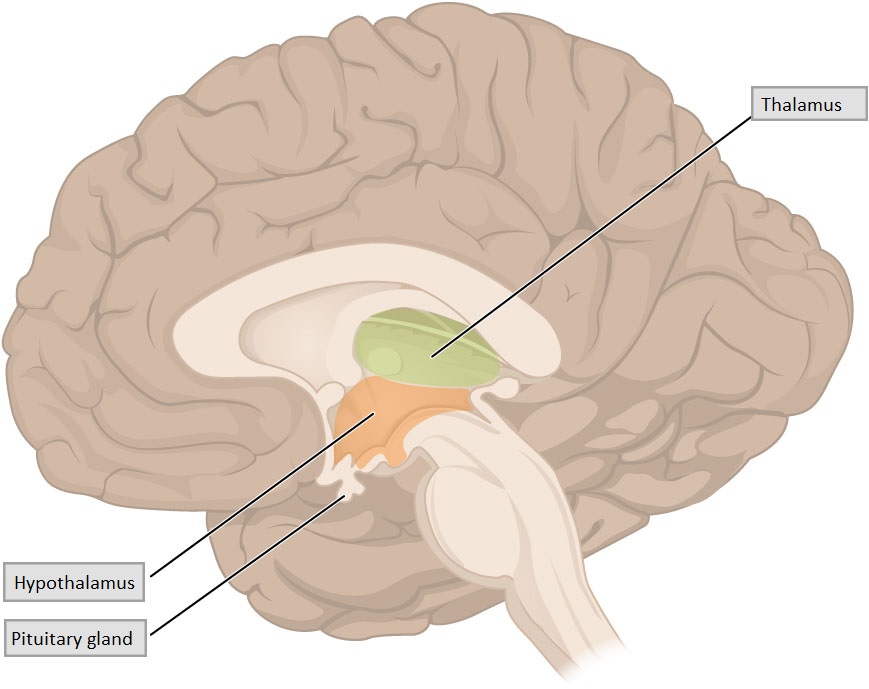Chapter 3. Digestion, Absorption, and Elimination
What Drives Us to Eat? Hunger vs. Appetite
Hunger vs. Appetite

When people think about hunger and appetite, they often use the terms interchangeably. However, these terms are not interchangeable.
The simplest way to differentiate between the two is that hunger is physiological, whereas appetite is psychological. So when you see the dog staring longingly at that lovely tart, do you think hunger or appetite is driving this?
Hunger
Hunger is a physiological sensation that drives us to eat when we need food. It’s what we call non-specific, which means that it can be satiated by any food. Hunger originates in the hypothalamus (See Figure 3.1) and because it’s a physiological sensation, it can often feel uncomfortable.

Hunger is…
- Related to the amount and type of food we eat.
- From hormones, neuropeptides, and neurotransmitters.
- From nerve cells in other regions of the body.
The Amount and Type of Food We Eat
The term satiety or satiation relates to the inhibition of eating experienced following food consumption. Compared to carbohydrates or fats, proteins have the highest satiety value, followed by carbohydrates, and then fats, so if you want to stay full for longer, it is important to include protein in your meals.
Meals that contain more water and fibre (also called bulky) can stretch the stomach more than meals that contain less fibre and water. The stretching of the stomach signals the hypothalamus that you are full and prevents further eating.
One final aspect of food that plays a role in satiety is related to the form of food you eat. Have you ever drunk a frappuccino and not felt full afterwards, but then ate a bowl of granola with yogurt and felt full? Having experienced something similar to this can highlight the role food form plays in satiety. Liquids tend to be the least satiating and solid food the most. There is also evidence that satiety occurs more quickly and lasts longer following solid food when compared to liquid food.[1]
Hormones, neuropeptides and neurotransmitters
Definitions
Hormones are chemical messengers secreted by endocrine glands that travel in your bloodstream to tissues or organs.[2] They are involved in many bodily processes such as growth and development, reproduction, and mood, as well as key aspects surrounding nutrition such as digestion and metabolism.
Neuropeptides are peptides secreted from neurons.[3]
Neurotransmitters “are chemical signals released from presynaptic nerve terminals into the synaptic cleft.” [4]
Hormones such as insulin and glucagon play a role in maintaining blood glucose levels. Low blood glucose can trigger feelings of hunger that, by signalling the hypothalamus, drive us to eat. When blood glucose levels are high and the stomach is stretched from eating, this, and other signals from the gut provide a feeling of satiety, which encourages us to stop eating. Neuropeptides and neurotransmitters can also play a role in hunger and satiety. For example, Neuropeptide Y and galanin (both neuropeptides) trigger hunger, whereas leptin (hormone), cholecystokinin (hormone), and serotonin (neurotransmitter) all play a role in satiety.
Nerve Cells
Nerve cells are cells that line the stomach and small intestine. They detect changes in pressure and send signals to the hypothalamus which integrates a response, causing us to eat or feel full. When you have just eaten, the stomach or small intestine becomes distended/ full of nutrients which causes these nerve cells to send a signal to the hypothalamus, triggering feelings of satiety. In contrast, when the stomach is empty, this lack of distention and nutrients is integrated in the hypothalamus and results in feelings of hunger.
Appetite
Appetite is a psychological desire to consume a particular food that can be triggered by things related to our culture, society and environment (e.g., activities and occasions, time of day, being with certain people, events causing an emotional response, a particular place); information provided by our senses (e.g. sight, smell, taste, texture and sound); factors that we learn over time (e.g., from our family, community, culture, religion and exposure through things such as education).
Media Attributions
- A dog staring at tart © Charles Deluvio
- The hypothalamus, thalamus, and pituitary gland © Open stax is licensed under a CC BY (Attribution) license
- Leathwood P, Pollet P. Effects of slow release carbohydrates in the form of bean flakes on the evolution of hunger and satiety in man. Appetite. 1988;10:1–11. ↵
- https://medlineplus.gov/hormones.html ↵
- Zup Susan L., Park Jin Ho, Dominguez Juan M. Front. Behav. Neurosci., 22 April 2022 Sec. Behavioral Endocrinology Volume 16 - 2022 | https://doi.org/10.3389/fnbeh.2022.886591 https://www.frontiersin.org/articles/10.3389/fnbeh.2022.886591/full ↵
- https://www.ncbi.nlm.nih.gov/books/NBK10957/ ↵

